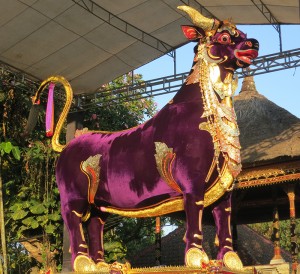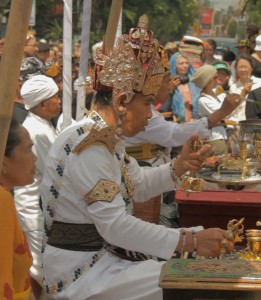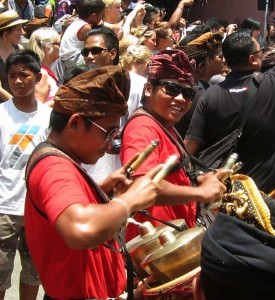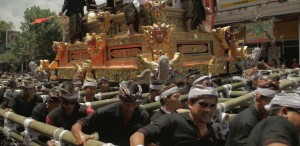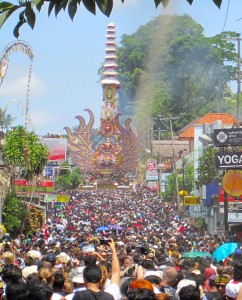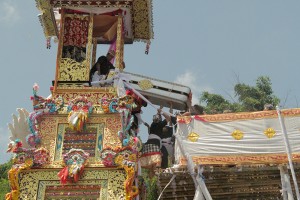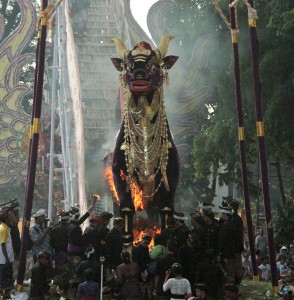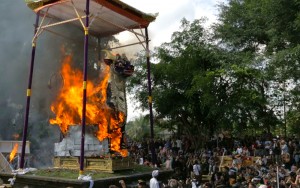In Ubud, all roads seem to lead passed the palace and in the street in front of the palace we spied an enormous purple bull and a very tall and elaborate tower under construction behind it.
Knowing a little about Balinese customs, we guessed that this was for an important funeral and our Balinese friends confirmed that.
The wife of the heir to the throne of Ubud had died in October and her cremation was to take place on 1 November.
Over three or four days, the enormous tower took shape along with a huge ramp beside it.
At almost the very top of the tower was a section that looked like a throne – and it was there that the coffin of the Queen was to be placed. After a ceremony in the palace, the body was to be carried up the ramp and placed on this lofty throne.
At the base of the tower and the bull was a grid made from hefty sections of bamboo and it was into this grid that a succession of teams of men would climb to carry them both the kilometer or so to the cremation site – about 300 for the tower and about half that for the bull.
In preparation for this, on the day before the ceremony, all the electric wires that crossed the one kilometer of street to the cremation site were removed – meaning that all the businesses on that side of the street either went without electricity or used a generator.
Many of the ones that did use a generator clearly did it regularly because they had a permanent point on the front of the shop into which the generator was plugged, leaving the generator ticking over on the footpath.
Of course, we took the opportunity to film it.
On the morning of the cremation, we went to the cremation site and secured a camera position inside a stand close to the raised platform on which the bull would be placed. Cameron and one of our Balinese friends stayed there to keep our prime position while I walked the kilometre to the palace.
At the palace two very richly dressed priests sheltering under a specially erected canopy were reciting prayers and giving blessings.
A crowd of both locals and tourists milled around the enormous bull and the colourful tower while the royal gamalan orchestra played in a pavilion next door.
This orchestra was quite large and while to our ears there is not a lot of structure to the music, if you sit and watch for a while you can see how complex and demanding this music really is.
As I watched I decided that one bespectacled thin man at the front of the orchestra was the leader.
He wielded a couple of large hammers on a set of metal tongues laid out in front of him like the keys of a piano.
What made me think he was the leader was his very studied concentration and the flourish with which he would wield his hammers – as if he were giving timing signals to the rest of the orchestra behind him.
When I detected movement at the Palace, I took up a position down the road where I would be able to film the advance of the bull and the tower.
I was lucky to reach an intersection just as another burial parade surged into the road.
I found myself standing in a large and very noisy mobile gamalan orchestra.
Lead by two young men who stood surrounded by the orchestra, the music was fast, joyful and powerful. The two leaders wore harnesses across their shoulders from which hung a frame holding two large gongs lying flat in front of them.
These they beat frenetically with what looked like two steel and gold pestle ( as in mortice and pestle) . These they spun on the air with the flourish of a band major signalling to the other band members who crowded around them beating gongs and cymbals and drums of all sizes.
For this funeral, the bull and the tower were much smaller than the Queen’s. In fact, the bull, which in this case was white, was small enough to carry a rider who clung on while the men carrying it span it around and rocked it like a carnival ride.
This was followed by a large throne, big enough for two guys to stand on as fifty or so men span it and danced it through the intersection.
Next came the Queen’s procession.
Now I expected that when the Queen’s parade was to come along the road, with such heavy loads and with so many people carrying them, that progress would be slow and measured – especially since the base of the tower barely fitted in the roadway.
But I was wrong!
Once lifted, the men began to run down the road at an astonishing pace. Before them ran police and other men shouting and waving frantically.
It was immediately clear that there would be no room, even on the footpath, for me!
I did the best I could to get out of the way and only managed it by climbing over a motorbike parked on the footpath – you will see a couple of bits in the image where the camera stalled – I think that’s me stumbling over the motorbike – but I managed to keep the camera rolling.
The bull made it through without mishap, but as the tower came passed it collided with festival poles in the pavements bringing them down like a falling tree.
As it passed, I joined a densely packed crowd following the procession.
At this point, the heat became intense.
Up to the low 30’s (Celsius that is), I’m OK. But inside the crowd, the temperature was much higher than that – and there was much worse to come.
I followed along behind the tower as it made its way to the cremation site – pushing hard through the crowd to get close enough to film.
It turned sharply and moved up the small incline to the cremation site.
From his vantage point, Cameron was able to film its entrance to the square as it lined up to the huge ramp placed there to transport the body to the ground.
I muscled myself into a position where I was able to look up at the attendants transferring the coffin from the seat of the throne to the top of the ramp.
Here, much earlier, a fire truck had thoroughly whetted down the blacktop and with the heat of midday the water turned to steam which floated up through the dense crowd.
Now the temperature must have climbed into the 40’s and I was feeling it!
But, looking up at the throne and coffin and ramp it was obvious that there had been a miscalculation.
The coffin, which protruded from the seat of the throne almost like a diving board was higher than the ramp. So high, in fact, that the attendants could barely lay their hands on it!
Minutes passed while men prepared a kind of sling made from long pieces of white cloth to be used to hold the coffin while it was edged out into space.
Other men standing twenty metres in the air, straddled the gap between the ramp and the tower, their arms stretched high to catch the coffin as it was carefully lowered.
A cheer rang out when the coffin suddenly dropped half a metre and was caught on the fingertips of these men.
While this was going on, to the music of another gamalan orchestra set up in the stand, a team of men had lifted the bull onto the podium beneath a tall canopy.
The coffin was paraded three times around the podium before being hoisted up and inserted through the rear of the bull and into its belly.
A traditional guard (of old men) dressed as medieval soldiers carrying shields, spears and Balinese swords (called a Kris) also marched around the podium.
More prayers and then a group of men, members of the family, climbed up onto the podium and with flaming torches, set fire to the bull.
The orchestra played while the crowd watched the flames eagerly lick their way up, over and into the bull.
After a short time, the coffin fell from the bull’s belly and into a screened trough under the bull.
Now men with what looked like thermic lances approached the podium and aimed their incendiary long poles into the trough.
There was the roar of burning gas from these lances as they incinerated the coffin beneath the bull.
We watched as the bull was burn away to a frame with a bulls head while the men stood beneath the bull aiming their lances into the trough.
Suddenly, the bull’s head began to lower. Slowly at first and then it fell freely in an arc. Men scrambled out of the way as it collided with a lance sending an explosion of fiery gas into the air.
With this crescendo, calmness settled on the scene and the crowd began to dissipate.
By this stage, we were all about to suffer heat stroke and we packed up our gear a looked for the nearest cold beer.
Once the ashes had cooled, members of the family would have sifted the remains from the ashes, washed them in milk and the next day would have rowed them out to sea for a final burial.
Over the next couple of days, local people would dismantle the tower, bit by bit, and burn it.
As we left the cremation site, gangs of men were already restringing power lines along the street.
Within a few hours, all would return to normal – well, normal for Bali.
See more videos on the Robertson Guides YouTube Channel
